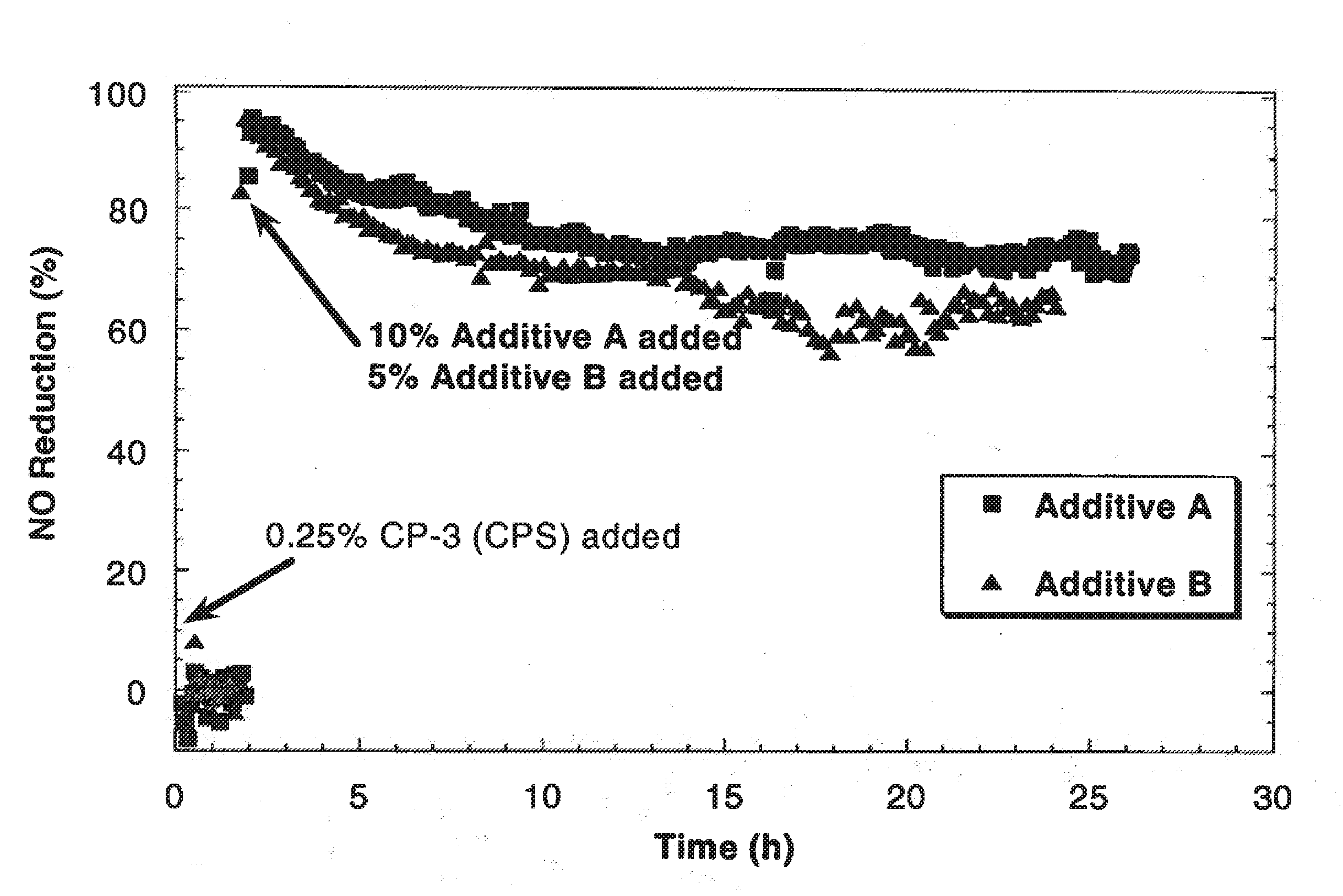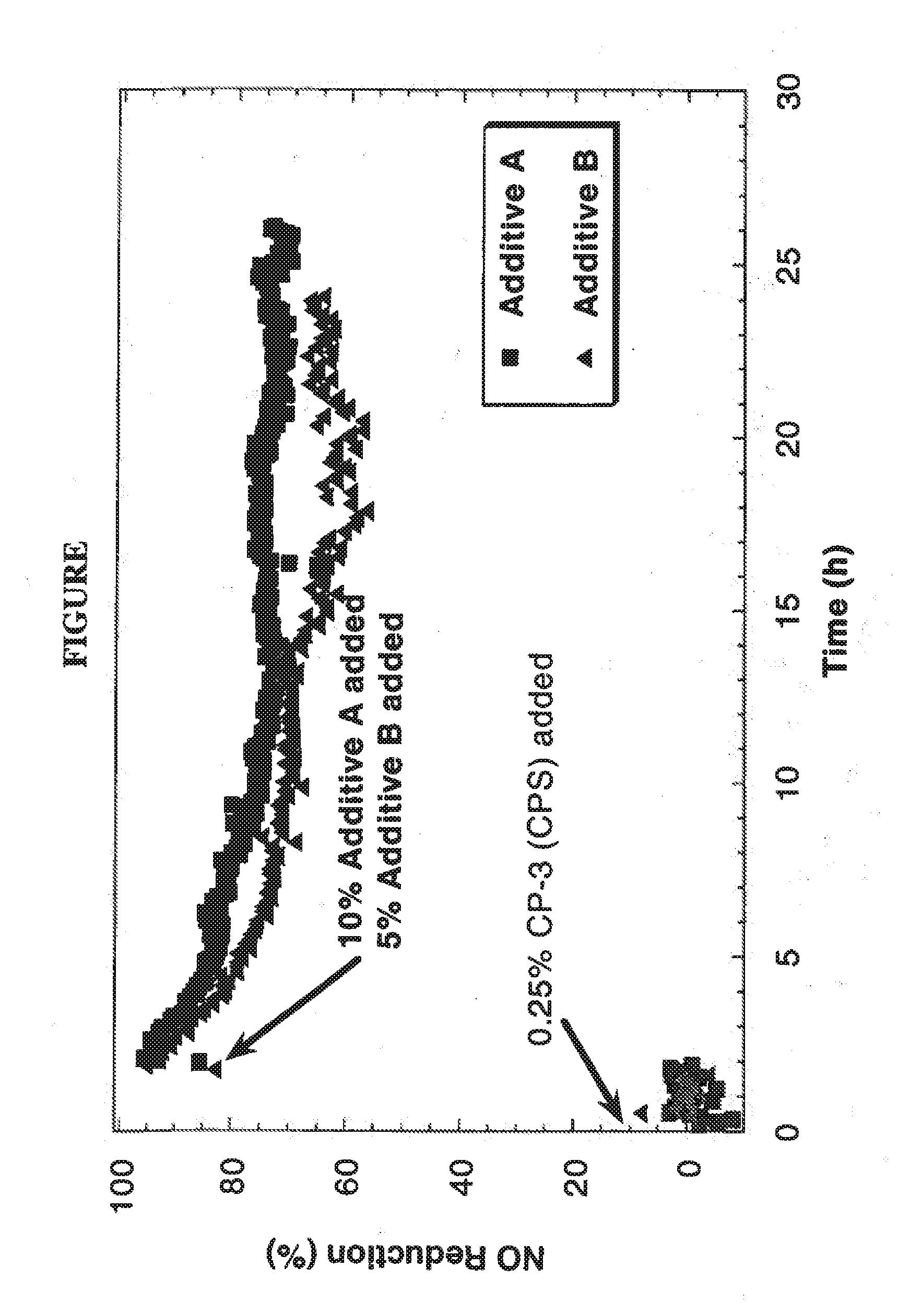Ferrierite composition for reducing NOX emissions during fluid catalytic cracking
a technology of nox emission and ferrite composition, which is applied in the direction of physical/chemical process catalysts, metal/metal-oxide/metal-hydroxide catalysts, and separation processes, etc. it can solve the problem of reducing the production of more valuable products, reducing the feed throughput of the unit, and affecting the production of nox emissions. the effect of reducing nox
- Summary
- Abstract
- Description
- Claims
- Application Information
AI Technical Summary
Benefits of technology
Problems solved by technology
Method used
Image
Examples
example 1
[0065]A composition comprising 40% ferrierite, 40% clay and 20% silica sol (Additive A) was prepared as follows. An aqueous slurry containing 29% ferrierite (SiO2 / Al2O3=20) was milled in a Drais mill to an average particle size of less than 2.5 μm. The milled ferrierite slurry (4160 g) was combined with 1200 g Natka clay (dry basis) and 6000 g silica sol binder (10% solids). The silica sol binder was prepared from sodium silicate and acid alum. The catalyst slurry was then spray-dried in a Bowen spray drier. The resulting spray-dried product was washed with ammonium sulfate solution, followed by water to give a catalyst with a Na2O level of less than 0.1 weight percent. The properties of the additive are shown in Table 1 below.
example 2
[0066]A composition comprising 75% ferrierite and 25% alumina sol (Additive B) was prepared as follows. An aqueous slurry was prepared which contained 2174 g of aluminum chlorohydrol solution (23% solids), 1500 g (dry basis) of ferrierite (SiO2 / Al2O3=20, Na2O+K2O<0.2) and enough additional water to make a slurry which contained about 40% solids. The slurry was milled in a Drais mill to an average particle size of less than 2.5 μm and then spray-dried in a Bowen spray dryer. The spray-dried product was calcined for 90 minutes at 1100° F. The properties of the catalyst are shown in Table 1 below.
example 3
[0067]Additives A and B were evaluated for their ability to reduce NOx emissions from a FCCU using the Davison Circulating Riser (DCR). The description of the DCR has been published in the following papers: G. W. Young, G. D. Weatherbee, and S. W. Davey, “Simulating Commercial FCCU Yields With The Davison Circulating Riser (DCR) Pilot Plant Unit,” National Petroleum Refiners_Association (NPRA) Paper AM88-52; G. W. Young, “Realistic Assessment of FCC Catalyst Performance in the Laboratory,” in Fluid Catalytic Cracking: Science and Technology, L S. Magee and M. M. Mitchell, Jr. Eds. Studies in Surface Science and Catalysis Volume 76, p. 257, Elsevier Science Publishers WV., Amsterdam 1993, ISBN 0-444-89037-8.
[0068]The DCR was started up by charging the unit with approximately 1800 g of a commercially available cracking catalyst, SUPERNOVA®-DMR+, obtained from Grace Davison, hydrothermally deactivated in a fluidized bed reactor with 100% steam for 4 hours at 816° C.
TABLE IProperties of...
PUM
| Property | Measurement | Unit |
|---|---|---|
| mean particle size | aaaaa | aaaaa |
| weight percent | aaaaa | aaaaa |
| weight percent | aaaaa | aaaaa |
Abstract
Description
Claims
Application Information
 Login to View More
Login to View More - R&D
- Intellectual Property
- Life Sciences
- Materials
- Tech Scout
- Unparalleled Data Quality
- Higher Quality Content
- 60% Fewer Hallucinations
Browse by: Latest US Patents, China's latest patents, Technical Efficacy Thesaurus, Application Domain, Technology Topic, Popular Technical Reports.
© 2025 PatSnap. All rights reserved.Legal|Privacy policy|Modern Slavery Act Transparency Statement|Sitemap|About US| Contact US: help@patsnap.com


